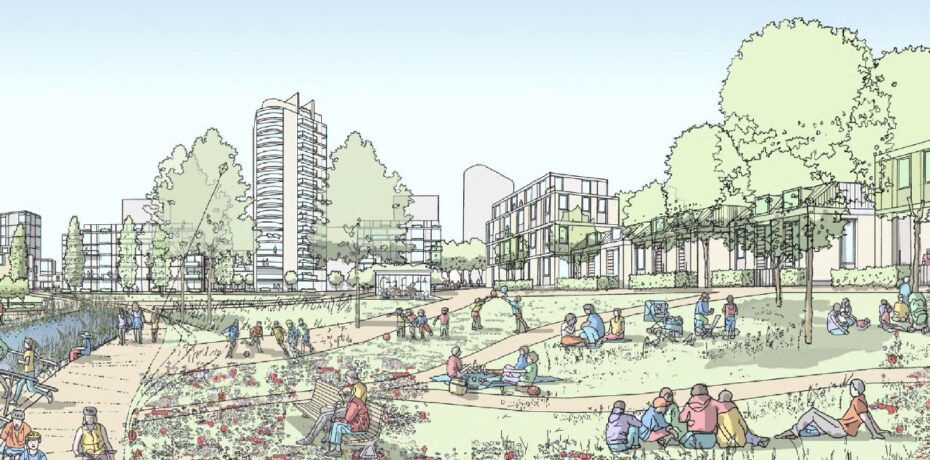SPECIAL REPORT | FEC outlines ambitions for £1bn Northern Gateway
Green spaces will be created from the outset at FEC’s £1bn Northern Gateway to “change perceptions”, the project’s director Tom Fenton has said, with other areas being explored for the 15,000-home project including a New York High Line-style link to Victoria Station, a new transport hub, and a “Brewery Quarter”.
FEC’s strategic regeneration framework for the area, which stretches from Victoria Station to Queens Park via Collyhurst, was first announced at the MIPIM property conference in Cannes in March this year.
The developer has been working with Manchester City Council since then, alongside a professional team featuring masterplanner Farrells; Turner & Townsend; landscape architect Planit-IE; Arup; Buro4; and planner GVA How.
This has culminated in a strategic regeneration framework for the area, due to be endorsed by the council’s executive today.
Split into seven neighbourhoods, the framework outlines residential-led development starting around Victoria Station and following the passage of the River Irk, incorporating Sandhills Park, Collyhurst, the Smedley Dip, and New Cross.
Tom Fenton, who has been leading on the project for FEC, said the framework breaks the existing area down into “new and reinvigorated neighbourhoods” each with a different but unified approach.

The area has been split into seven neighbourhoods
Closest to the Victoria Station, Red Bank has the potential to house tall buildings alongside public squares; the existing Red Bank viaduct is also set to be re-used either as a park or a green link to Victoria Station. Fenton said the team had been using New York’s High Line as a design precedent.
A number of ideas are being considered to improve access to the city including a potential north-facing entrance for Victoria, added Fenton.
Also at Red Bank, Fenton said there were plans for a public square to form part of a “Brewery Quarter”, where businesses based in the railway arches will be retained and supported throughout the redevelopment, with FEC “committed” to keeping the character of the area intact.
Red Bank also incorporates Angelgate, likely to be rebranded after FEC bought the site earlier this year from collapsed developer Pinnacle Angelgate; a design team is currently being assembled with a planning application expected towards the end of this year.
“At Red Bank, the Angelgate site is the logical place for us to start, and it was always our intention to deliver something different from what was previously consented,” Fenton said, with the design team “starting with a blank sheet of paper” on the site. After Angelgate, FEC is expected to look at two neighbouring plots as its next developments in Red Bank.
Red Bank, however, will not be the first site within the Northern Gateway to be developed; the first homes will be built in Collyhurst, with around 400 to be delivered directly by FEC. Around 110 of these will be affordable.
A fifth of these will be designated as affordable homes, and the focus will be on family housing built on vacant plots; the mix being developed but will likely include semi-detached, terraces and mews-style accommodation. Fenton said the closest equivalent to the density and layout of Collyhurst would be the modern redevelopment of Hulme, south of Manchester city centre.
Apartment blocks of up to six storeys could be brought forward on more prominent corner sites facing Rochdale Road.

Affordable housing will be included in all seven neighbourhoods
The funding for the first batch of houses is currently in the Government’s hands, but if the council is successful in having the funding released, FEC is hopeful of a planning application for these submitted next year.
There will be affordable housing across all seven neighbourhoods, which will come forward on a phased basis, with Eggington Street and Smedley Dip likely to be the last neighbourhood to be developed.
However, Fenton added much of the initial development will not be solely focussed on housing; the parks and green spaces throughout the framework are a key part of the masterplan and will likely be delivered “from the outset”.
“We want to create those green spaces first to change perceptions of the area from day one,” said Fenton, who said this work could take around two to three years to complete.
Transport infrastructure is also at the forefront of Fenton’s mind in the emerging plan; a new district centre around a proposed multi-modal transport hub will form the centrepiece of the proposed Vauxhall Gardens neighbourhood.
This will also feature facilities such as restaurants, cafes, and retail and is being designed as the “centre” of the entire project.
FEC is hopeful of this featuring a new Metrolink stop, and Fenton said he was open to the possibility of this being funded directly by FEC and by the council, rather than having to wait for Government funds to become available.
The developer is also targeting both Made To Move – the city’s walking and cycling fund – and the Housing Investment Fund as two sources to help kick off transport projects.

Ex-Urban Splash man Fenton joined FEC from Capital & Centric in July last year
“We don’t want to fight against Rochdale Road being a commuter route, for example, but we want it to be much easier for people to cycle and walk in and out of the city along that route,” said Fenton.
Land ownership across the area could prove to be an issue, however, with the council and FEC currently owning about 50% of the land required to deliver the scheme.
A number of projects – including MCR Property Group’s holdings at Gould Street which have the capacity for a £250m, 1,200 home development – now fall under FEC’s framework, but Fenton said there had been “a lot of dialogue between the key stakeholders” across the area.
“We’d encourage other people to bring forward development that can give the Northern Gateway more momentum,” he said. “I don’t think compulsory purchase order powers will ever been needed when it comes to larger developers, but there are some places where it might be needed, where land ownership is much more fragmented.”
The latest framework supercedes a number of existing masterplans, including the Irk Valley framework, but Fenton said there would be “no changes” to the existing framework for Zone A of New Cross, bordered by Thompson Street to the North.
Around this area, public realm improvements including a square are planned around the Marble Arch pub, while existing buildings along Rochdale Road including the Wing Yip and the Royal Mail facilities are likely to be left in place – although Fenton said FEC would be open to looking at these sites if they were to be opened up for development.
Land at New Cross has been reserved for future public use, including a secondary school and potentially a leisure centre, following the model of the Hough End Leisure Centre on Princess Parkway, designed as a “stop-off” gym and leisure facility for people commuting in and out of the city.
New Town, sitting between New Cross and Red Bank and bisected by the train lines in and out of Victoria, will likely be high density due to its proximity with the city, but like all the other neighbourhoods, will also include family housing.
An eight-week consultation is expected to start in early August, followed by any feedback being weaved into the framework by FEC’s design team throughout October. The final framework is likely to go to the council executive for final approval in November.

Plans include a “Brewery Quarter” around the Red Bank Viaduct




